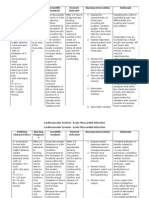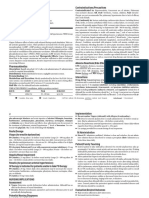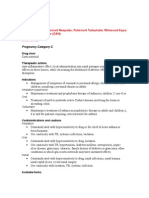Operating Room Drugs
Operating Room Drugs
Uploaded by
Ian Kenneth Da SilvaCopyright:
Available Formats
Operating Room Drugs
Operating Room Drugs
Uploaded by
Ian Kenneth Da SilvaOriginal Description:
Copyright
Available Formats
Share this document
Did you find this document useful?
Is this content inappropriate?
Copyright:
Available Formats
Operating Room Drugs
Operating Room Drugs
Uploaded by
Ian Kenneth Da SilvaCopyright:
Available Formats
OPERATING ROOM DRUGS
1) Tranexamic Acid/ hemostan(antifibrinolytic): often prescribed for excessive bleeding. It is an antifibrinolytic that competitively inhibits the activation of plasminogen to plasmin, a molecule responsible for the degradation of fibrin. 2) Ephedrine SO4- A piperazine derivative with antihistamine, antiemetic, and anxiolytic properties.; relaxes bronchial smooth muscle, produces vasodilation (except in cerebral vessels), stimulates the CNS, stimulates cardiac muscle, induces diuresis, and increases gastric acid secretion; it may also suppress inflammation and improve contractility of the diaphragm.
3) Epinephrine- is a hormone and neurotransmitter. It increases heart rate, contracts blood vessels, dilates air passages and participates in the fight-or-flight response of the sympathetic nervous system. Chemically, epinephrine is a catecholamine, a monoamine produced only by the adrenal glands from the amino acids phenylalanine and tyrosine.
4) Atropine SO4- a sympathetic, competitive antagonist of muscarinic cholinergic receptors, thereby abolishing the effects of parasympathetic stimulation. This agent may induce tachycardia, inhibit secretions, and relax smooth muscles. 5) Atracurium- a neuromuscular-blocking drug or skeletal muscle relaxant in the category of non-depolarizing neuromuscular-blocking drugs, used adjunctively in anesthesia to facilitate endotracheal intubation and to provide skeletal muscle relaxation during surgery or mechanical ventilation. Atracurium is classified as an intermediate-duration non-depolarizing neuromuscular blocking agent. 6) Norcuron- a nondepolarizing neuromuscular blocking agent; It acts by competing for cholinergic receptors at the motor end-plate 7) Succinylcholine- has the briefest duration of action of all neuromuscular blocking drugs, making it a drug of choice for such procedures as terminating laryngospasm, endotracheal intubation, and electroconvulsive shock therapy.Like nondepolarizing blockers, depolarizing drugs also bind to the nicotinic M receptors for acetylcholine. However, because they cause an initial depolarization of the muscle membrane, they often lead to fasciculations and some muscular contractions prior to inducing paralysis. 8) Mannitol- an osmotic diuretic agent and a weak renal vasodilator; mannitol increases water and Na+ excretion, thereby decreasing extracellular fluid volume.
Da Silva, Ian Kenneth BSN IV-4 Group C
9) Dopamine- inhibit the release of prolactin from the anterior lobe of the pituitary; acting on the sympathetic nervous system, producing effects such as increased heart rate and blood pressure. However, because dopamine cannot cross the blood-brain barrier, dopamine given as a drug does not directly affect the central nervous system. To increase the amount of dopamine in the brains of patients with diseases such as Parkinson's disease and dopa-responsive dystonia, L-DOPA, which is the precursor of dopamine, can be given because it can cross the blood-brain barrier. 10) NaHCO3- serves to neutralize the acidity of the hydrochloric acid produced by the stomach, and is excreted into the duodenum of the small intestine via the bile duct. for acid indigestion and heartburn. 11) Ketanov- a non-steroidal anti-inflammatory drug (NSAID) in the family of heterocyclic acetic acid derivative, often used as an analgesic, antipyretic (fever reducer), and anti-inflammatory. Ketorolac acts by inhibiting the bodily synthesis of prostaglandins. 12) Demerol- narcotic pain relievers. It works by dulling the pain perception center in the brain. 13) Fentanyl- a potent narcotic analgesic with a rapid onset and short duration of action.[5] Historically it has been used to treat chronic breakthrough pain and is commonly used pre-procedures. 100 times more potent than morphine 14) Morphine- a potent opiate analgesic. 16) Dormicum/ Midazolam- is a short-acting drug in the benzodiazepine class that is used for treatment of acute seizures and for inducing sedation and amnesia before medical procedures. It has potent anxiolytic, amnestic, hypnotic, anticonvulsant, skeletal muscle relaxant, and sedative properties.[Midazolam has a fast recovery time and is the most commonly used benzodiazepine as a premedication for sedation; less commonly it is used for induction and maintenance of anesthesia. Flumazenil is a benzodiazepine antagonist drug that can be used to treat an overdose of midazolam as well as to reverse sedation. 17) Nubain- is a synthetic opioid agonist-antagonist analgesic of the phenanthrene series; potent opioid analgesic 18) Syntocinon/ oxytocin- exerts a selective action on the smooth musculature of the uterus,
Da Silva, Ian Kenneth BSN IV-4 Group C
19) Methergin- Methergin is a semisynthetic ergot alkaloid and a derivative of ergonovine and is used for the prevention and control of postpartum and post-abortion hemorrhage. In general, the effects of all the ergot alkaloids appear to results from their actions as partial agonists or antagonists at adrenergic, dopaminergic, and tryptaminergic receptors. 20)Siverol/ Tramadol- Moderate to severe pain esp post-op or due to trauma, colic, ischemia or cancer. 21) Dynastat/ parecoxib- Short term treatment of acute pain & post-op pain. May be used pre-op to prevent or reduce post-op pain; can reduce opioid requirements when used concomitantly. 23) Stadol/ Butorphanol tartrate- Relief of moderate to severe pain. Pre-, intra- & postop analgesia or pre-anesth medication, as a supplement to balance anesth, & for relief of prepartum & postpartum pain. 24) Chloramphenicol- effective against a wide variety of Gram-positive and Gramnegative bacteria, including most anaerobic organisms. Due to resistance and safety concerns, it is no longer a first-line agent for any indication in developed nations, although it is sometimes used topically for eye infections. 25) Diazepam/ valium- is commonly used for treating anxiety, insomnia, seizures including status epilepticus, muscle spasms, restless legs syndrome, alcohol withdrawal, benzodiazepine withdrawal and Mnire's disease. It may also be used before certain medical procedures (such as endoscopies) to reduce tension and anxiety, and in some surgical procedures to induce amnesia. It possesses anxiolytic, anticonvulsant, hypnotic, sedative, skeletal muscle relaxant, and amnestic properties. The pharmacological action of diazepam enhances the effect of the neurotransmitter GABA by binding to the benzodiazepine site on the GABAA receptor leading to central nervous system depression. 26) Prostigmine- a parasympathetic drug that acts as a reversible inhibitor to acetylcholinesterase, an enzyme which breaks down acetylcholine (ACh) in cholinergic nerve endings. It can be used clinically to treat myasthenia gravis, paralytic ileus, and urine retention. 27) Orudis/ Ketoprufen- a nonsteroidal anti-inflammatory drug with analgesic and antipyretic effects.It acts by inhibiting the body's production of prostaglandin.
Da Silva, Ian Kenneth BSN IV-4 Group C
You might also like
- NCP Risk For Impaired AttachmentDocument1 pageNCP Risk For Impaired AttachmentDanielle MerlinNo ratings yet
- NCP 2 and Soapie 1Document5 pagesNCP 2 and Soapie 1narsD100% (1)
- Drug Benzocaine LozengeDocument1 pageDrug Benzocaine LozengeSrkocherNo ratings yet
- Or Write Up 52611Document14 pagesOr Write Up 52611babydumplingsNo ratings yet
- Drug StudiesDocument16 pagesDrug Studiesvitcloud23100% (2)
- Spinal Anes Drug StudyDocument12 pagesSpinal Anes Drug StudyNicosia Mae FerrerNo ratings yet
- Drug Study Ampicillin, CelestamineDocument5 pagesDrug Study Ampicillin, CelestamineLLan Kristine Lazarito100% (1)
- NCP For Pre-Op Incision CaseDocument8 pagesNCP For Pre-Op Incision CaseFAt TyNo ratings yet
- Drug StudyDocument3 pagesDrug StudyKristine Faith AzcuetaNo ratings yet
- Delivery Room Drug StudyDocument11 pagesDelivery Room Drug StudyChinimansiNo ratings yet
- Drug StudyDocument9 pagesDrug StudyAlexander Chavez Alto100% (1)
- KetorolacDocument4 pagesKetorolacx483xDNo ratings yet
- Drug Study - CapDocument5 pagesDrug Study - CapABARAJNo ratings yet
- Drug Study DMDocument7 pagesDrug Study DMElaisa Mae Delos SantosNo ratings yet
- DRUG-STUDY Butorphanol LRDR AngelicaRonquilloDocument2 pagesDRUG-STUDY Butorphanol LRDR AngelicaRonquillokarl eiron delos santosNo ratings yet
- DS HaloperidolDocument3 pagesDS HaloperidolbillyktoubattsNo ratings yet
- Drug Study For Postpartum MothersDocument5 pagesDrug Study For Postpartum MothersnnicakoNo ratings yet
- Student Nurses' Community: Nursing Care Plan RabiesDocument2 pagesStudent Nurses' Community: Nursing Care Plan RabiesYanis Emmanuelle LimNo ratings yet
- Surgical Skin PreparationDocument2 pagesSurgical Skin PreparationVanny Vien JuanilloNo ratings yet
- NCP .Postoperative.Document5 pagesNCP .Postoperative.Jerome GazmenNo ratings yet
- Pathophysiology / Explanation of The ProblemDocument1 pagePathophysiology / Explanation of The ProblemArian May MarcosNo ratings yet
- Drug Study For FractureDocument4 pagesDrug Study For FractureitsmeayaNo ratings yet
- Prescribed Medication: Information Leaflet PriorDocument4 pagesPrescribed Medication: Information Leaflet PriorHavier EsparagueraNo ratings yet
- ATENOLOLDocument1 pageATENOLOLRPh Krishna Chandra JagritNo ratings yet
- Im Case Study 04Document49 pagesIm Case Study 04Shaine BalverdeNo ratings yet
- Ketorolac Drug StudyDocument1 pageKetorolac Drug Studyejg26No ratings yet
- Atropine SulfateDocument1 pageAtropine SulfateTrishaaMayolNo ratings yet
- SildenafilDocument2 pagesSildenafilSheryl Ann PedinesNo ratings yet
- Name of Drugs Indications Contraindications ADVERSE Reactions To Watch Out For Drug Interactions Nursing ConsiderationsDocument2 pagesName of Drugs Indications Contraindications ADVERSE Reactions To Watch Out For Drug Interactions Nursing ConsiderationsAlexis SilvestreNo ratings yet
- LevofloxacinDocument2 pagesLevofloxacinKatie McPeek100% (3)
- Postop Drug2Document3 pagesPostop Drug2zbestgurlNo ratings yet
- CeferoximeDocument1 pageCeferoximeGwen Stefanie Lagrimas ValloyasNo ratings yet
- Drug StudyDocument4 pagesDrug StudyKarla Karina Dela Cruz100% (1)
- Drug Name Mechanism of Action Indication Side Effects/ Adverse Effects Contraindicatio N Nursing ConsiderationDocument9 pagesDrug Name Mechanism of Action Indication Side Effects/ Adverse Effects Contraindicatio N Nursing ConsiderationVanessa Naomi GalidoNo ratings yet
- AmpicillinDocument1 pageAmpicillinMichael KuzbytNo ratings yet
- Ketorolac Drug StudyDocument2 pagesKetorolac Drug StudyAwani ONo ratings yet
- Calcium Gluconate Drug StudyDocument4 pagesCalcium Gluconate Drug StudyAngelou Joefred CongresoNo ratings yet
- Cefuroxime Sodium-Drug StudyDocument2 pagesCefuroxime Sodium-Drug Studyakire12No ratings yet
- Cefixime: Suprax Class and CategoryDocument3 pagesCefixime: Suprax Class and CategoryArianne Joy SalvadorNo ratings yet
- DiazepamDocument1 pageDiazepamkualamonkey100% (1)
- Functional Health PatternDocument3 pagesFunctional Health PatternGladys Pasaporte100% (1)
- TheophyllineDocument6 pagesTheophyllineapi-3797941100% (1)
- Case IcuDocument5 pagesCase IcuTrisha SuazoNo ratings yet
- DRUG STUDY Amoxicillin PDFDocument2 pagesDRUG STUDY Amoxicillin PDFMc SantosNo ratings yet
- DiphenhydramineDocument1 pageDiphenhydramineYanejoulce SacanleNo ratings yet
- AdenosineDocument2 pagesAdenosinegovind_soni_150% (1)
- Surgical TeamDocument9 pagesSurgical Teamkarenkaren09No ratings yet
- BudesonideDocument4 pagesBudesonideapi-3797941No ratings yet
- GAT NCP Surgery WardDocument4 pagesGAT NCP Surgery WardDon Richard0% (1)
- Mina Drug StudyDocument7 pagesMina Drug StudyChi Chaw Giselle HilarioNo ratings yet
- Iron Dextran Drug StudyDocument5 pagesIron Dextran Drug StudySofronio OmboyNo ratings yet
- Risk For InfectionDocument3 pagesRisk For Infectionprickybiik100% (1)
- Xii. Drug StudyDocument2 pagesXii. Drug StudyAela Maive MontenegroNo ratings yet
- Kabiven: (Amino Acids, Electrolytes, Dextrose and Lipid Injectable Emulsion), For Intravenous UseDocument24 pagesKabiven: (Amino Acids, Electrolytes, Dextrose and Lipid Injectable Emulsion), For Intravenous UseDivine Mercy De JulianNo ratings yet
- PremedicationDocument10 pagesPremedicationalihaiderinad0No ratings yet
- Anaesthesia presentationDocument75 pagesAnaesthesia presentationkhanfarhan.m.malik900No ratings yet
- Preoperative Patient AssessmentDocument5 pagesPreoperative Patient Assessmenthonovezaann.a.campita.ctucvmNo ratings yet
- Premedication: Moderator: DR - Dinesh Kaushal Presentsd By: DR Rajesh Raman & DR Gopal SinghDocument60 pagesPremedication: Moderator: DR - Dinesh Kaushal Presentsd By: DR Rajesh Raman & DR Gopal Singhramanrajesh83No ratings yet
- Sedation, Analgesia & Patient Controlled Analgesia 2Document28 pagesSedation, Analgesia & Patient Controlled Analgesia 2Arshad SyahaliNo ratings yet
- AnesthesiaDocument12 pagesAnesthesiaعلي الاسديNo ratings yet
- Oral Anti-Diabetic Semaglutide: A GLP-1 RA PeptideDocument11 pagesOral Anti-Diabetic Semaglutide: A GLP-1 RA PeptideInternational Journal of Innovative Science and Research TechnologyNo ratings yet
- Daftar PustakaDocument6 pagesDaftar PustakaNadya Nur KusumoNo ratings yet
- FS38 Drug Induced Parkinsonism - 0Document8 pagesFS38 Drug Induced Parkinsonism - 0Harnoor SinghNo ratings yet
- Tenofovir Disoproxil Fumarate: Therese M. Chapman, Jane K. Mcgavin and Stuart NobleDocument12 pagesTenofovir Disoproxil Fumarate: Therese M. Chapman, Jane K. Mcgavin and Stuart NobleBagusHibridaNo ratings yet
- Maklumat Vaksinasi: Vaccination DetailsDocument2 pagesMaklumat Vaksinasi: Vaccination Detailsdanial erham72No ratings yet
- Brand Name-Generic NameDocument2 pagesBrand Name-Generic NameAnonymous uosYCyXNo ratings yet
- Chapter 22 Sedative HypnoticsDocument7 pagesChapter 22 Sedative HypnoticsChristine Annmarie TapawanNo ratings yet
- Prescribing Drugs of Dependence in General Practice Part B BenzodiazepinesDocument101 pagesPrescribing Drugs of Dependence in General Practice Part B BenzodiazepinesjacksonzchenNo ratings yet
- Module For LESSON 3Document9 pagesModule For LESSON 3Maira Garcia C.No ratings yet
- Product Information For Human Medicinal Products HMV4Document61 pagesProduct Information For Human Medicinal Products HMV4CalimeroNo ratings yet
- Difficult Dogs IVAPMDocument15 pagesDifficult Dogs IVAPMRani JeyaramanNo ratings yet
- 2023 - The Clinical Application of Cariprazine in SchizophreniaDocument4 pages2023 - The Clinical Application of Cariprazine in SchizophreniaAna BorgesNo ratings yet
- GRAS Notice 000595 Gamma Aminobutyric Acid (GABA) PDFDocument132 pagesGRAS Notice 000595 Gamma Aminobutyric Acid (GABA) PDFAaam BertNo ratings yet
- 20 L Belladonna PDFDocument21 pages20 L Belladonna PDFAseelNo ratings yet
- Data Pasien TB JuliDocument42 pagesData Pasien TB JuliTsubbatun NajahNo ratings yet
- Care of The Controlled SubstancesDocument32 pagesCare of The Controlled SubstancesSapiah Raman0% (1)
- 400 3 NarcoticsDocument27 pages400 3 Narcoticsfirdaus92No ratings yet
- Finished Copy of Drug Formulary 29 MAy 2014 With PicturesDocument89 pagesFinished Copy of Drug Formulary 29 MAy 2014 With Picturesshameena1234No ratings yet
- Medication SafetyDocument68 pagesMedication SafetyPrince Jhessie L. Abella100% (9)
- Modul Skill Farmako Tht-MataDocument18 pagesModul Skill Farmako Tht-MatahanumNo ratings yet
- RX Cheat Sheet Pharmacy CrackDocument1 pageRX Cheat Sheet Pharmacy Crackramesh kumar100% (1)
- Sejarah Klasifikasi Antibiotik Dewi - 2017Document58 pagesSejarah Klasifikasi Antibiotik Dewi - 2017dr.syafril SpJPNo ratings yet
- Medication SafetyDocument114 pagesMedication SafetyRobert Dominic Gonzales100% (2)
- Vaccination CertificateDocument1 pageVaccination CertificateSivaa BapanapalliNo ratings yet
- Vice PPT 1 8 MergedDocument167 pagesVice PPT 1 8 MergedAissan PandaanNo ratings yet
- Summary of Medicine in MalaysiaDocument50 pagesSummary of Medicine in MalaysiagohyichengNo ratings yet
- Shortage List 2023Document24 pagesShortage List 2023nimirani2012No ratings yet
- How Do Drugs and Biologics DifferDocument2 pagesHow Do Drugs and Biologics DifferHellen RiveraNo ratings yet
- Klinik Winda: NO Nama Barang Satuan Harga Keterangan Beli JualDocument8 pagesKlinik Winda: NO Nama Barang Satuan Harga Keterangan Beli JualJoeliadi tariganNo ratings yet
- Questions - Answers - Positions On Specific Questionsaddressed Pharmacokinetics Working Party - enDocument48 pagesQuestions - Answers - Positions On Specific Questionsaddressed Pharmacokinetics Working Party - enlhthang1990No ratings yet

























































































